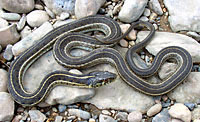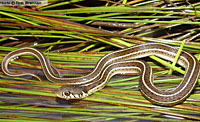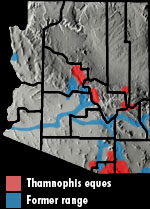Online Field Guide to The Reptiles and Amphibians of Arizona


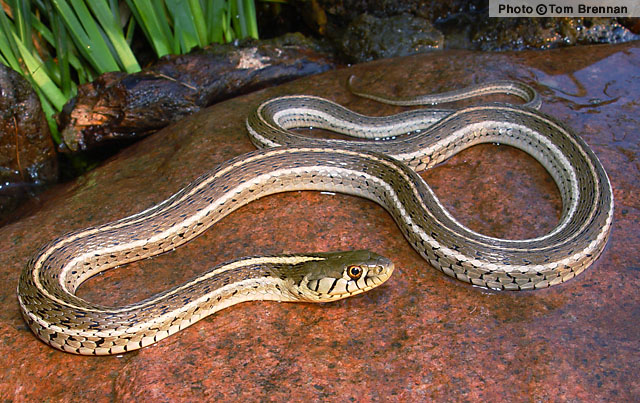
Gila County, AZ
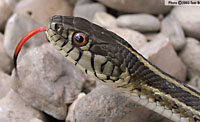 Yavapai Co., AZ |
||
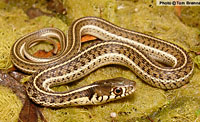 Neonate, Gila Co., AZ |
| MEXICAN GARTERSNAKE Thamnophis eques |
Non-Venomous
|
| DESCRIPTION: A medium (up to 1,120 mm or 44″ in total length) reddish-brown to olive-brown snake with a single cream colored stripe down the middle of the back (dorsal stripe). The dorsal stripe is crisp-edged and is sometimes bordered by a thin dark line along each side. An additional thin light stripe lines each lower side on the 3rd and 4th scale rows (counting up from the belly). Alternating blotches composed of short, dark, tightly stacked dashes mark the areas between the light stripes. These dark blotches do not intrude into the dorsal stripe. The underside is pale. Dark bars mark the seams of the upper lip scales (upper labials). The pupils are round and the dorsal scales are keeled.
DISTRIBUTION: This snake is now absent from much of its historic range in Arizona. It was once found in many of the sub-Mogollon Rim drainage systems across the central portion of Arizona and several drainage systems in south-central and southeastern Arizona. It remains in only a few isolated populations below the rim and in south central Arizona. Elevation ranges from about 1,000′ to about 6,700′. HABITAT: It is usually found in or near rivers, streams, and ciénegas in communities ranging from Arizona Upland Sonoran Desertscrub, through Semidesert Grassland and the woodlands, into Petran Montane Conifer Forest. DIET: The Mexican Gartersnake eats frogs, toads, fish, lizards, and small mammals. REPRODUCTION: Mating takes place in spring and young are born in June and July. REMARKS: Protected in Arizona. It is against Arizona State law to harass, harm, pursue, hunt, shoot, wound, kill, trap, capture, or collect this animal or to attempt to engage in any such conduct. Bartlett. 2000. Snakes of North America: Western Region. Gulf Publishing Co. Houston, TX Brennan, T. C., and A. T. Holycross. 2006. A Field Guide to Amphibians and Reptiles in Arizona. Arizona Game and Fish Department. Phoenix, AZ Brennan, T. C., and A. T. Holycross. 2005. A Field Guide to Amphibians and Reptiles of Maricopa County. Arizona Game and Fish Department. Phoenix, AZ Degenhardt, W. G., Painter, C. W., and Price, A. H.. 1996. Amphibians and Reptiles of New Mexico. University of New Mexico Press. Albuquerque. Fowlie. 1965. The Snakes of Arizona. Azul Quinta Press, Fallbrook, California Stebbins. 1985. Western Reptiles and Amphibians. Houghton Mifflin. New York, NY. |
|
Visit Partners in Amphibian and Reptile Conservation:


HOME
Copyright © 2023, Arizona Game and Fish Department. All rights reserved.
If you make use of the textual contents of this site in reports, publications, etc. please cite and credit the author(s) and photographer(s). All photos on this website are copyrighted. However, those found in the species account section may be used for any noncommercial scientific, educational, or conservation purposes provided that photographs are not altered and continue to bear the copyright symbol and name of the photographer. Please contact the photographer regarding commercial use of copyrighted photographs.










